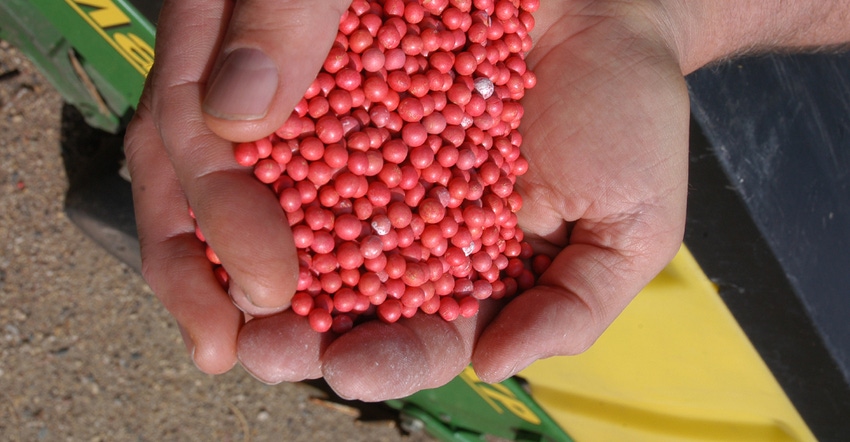February 21, 2018

It doesn’t seem that long ago when my team and I revolutionized seed treatments — a shining moment in my rookie year as a retail agronomist. Our customers had been mixing products into their planter boxes with broken shovel handles and sticks, which I didn’t see as a problem in need of a solution until our primary supplier started sending “advanced treatment units,” along with its seed treatment.
My crew and I led the charge, persuading customers to throw down those sticks and use this new thing, which was pretty much a section of exhaust pipe. After giving away all the “free” treatment units in just a couple of days, I called the sales rep for more. Turns out that exhaust pipe wasn’t free, sticks were, and thus ended the revolution.
What seed treatments do you need?
If we put the exhaust pipe fiasco of the early ’90s behind us and look at the industry today, we probably are in the midst of a revolution. We have so many choices of products for our seed. Inoculants, fungicides, insecticides, nematicides, nutrients, biostimulants, other biologicals and flow additives hit most, but probably not all, of the categories. Deciding what to add to the seed is not an exact science by any means, but a recent article "Should you eliminate soybean seed treatments?" gives some insight.
In that article, we talked about needing more data to get a good handle on the performance of treatments targeting soybean cyst nematode. ISU’s Dr. Greg Tylka and his team, along with the Iowa Soybean Association, have been looking at several of the SCN seed treatments over the last few years. With small plot and strip trial work across Iowa again in 2017, I was hoping that data would give us a lot of insight.
It’s a lot of data to try to summarize in a neat little package, so my caveat is to hop online and read through it if you are on the fence with using an SCN seed treatment. My take-away from reading through it was that while in some instances the seed treatments lowered SCN numbers or increased yields, there wasn’t much consistency across the trials as a whole. Hopefully, more work in 2018 and beyond will help us figure out how to use this segment of seed treatments more effectively.
DIY seed treatments
Along with rapid expansion in acres treated and variety of products we can put on soybean seed, there is another market emerging. With the increased interest in farmers treating their own seed versus having a seed dealer treat it, let’s hit on some common questions.
• What factors should be considered before farmers treat their seed? Multiple farmers have explained it to me this way, and it helped me understand their perspective. It’s a lot like the decision-making process of owning a sprayer and spraying their own crops vs. custom application. Do I want to own a sprayer? If so, pull-type or self-propelled? How much capacity do I need, and do I buy it with plans for expansion? Do I want to handle all the chemicals or not? Do I have time or manpower to do it myself? The same concepts are applicable to seed treatment.
We aren’t quite at that point yet, but here’s where I see the seed treatment sector headed: Some operations will DIY, some will have seed suppliers do it, and some may use a combination. And just like with the sprayer issue, we’ll see operations of all types and sizes making decisions that work for them. Over time as operations and seed treatment dynamics change, how growers approach seed treatments will evolve as well.
• What about the economics? Cost savings depends on factors like how many acres or units a farmer is treating, cost of the treating equipment, what sort of pricing growers can get on their treatment products compared to hiring it done at regular retail chemical pricing, and how many different products they are applying.
The numbers vary. A ballpark figure in savings that farmers mention is from $5 to $8 per unit for treating their own versus having a seed dealer do it. When it comes to putting in a treatment unit, I’ve seen everything from homemade “cement mixer” or trough-type units that guys have $10K or less in, up to commercial-grade treaters that can run well into six figures.
Again, farmers tell me that a lot of things play into the equipment decision: How many units can it treat at a time? How many products can be applied? How gently is the seed handled? How well is it mixed or evenly coated? What is cleanup and maintenance like? Is it upgradable? What’s the expected operational life? Is it user-friendly?
• Will on-farm treating be as good as commercial? If the words “It depends” could ever get me out of an uncomfortable spot, this is a good time. If a farming operation is using the same products, rates and proper procedures, then performance should reflect that. Commercial seed treatment equipment, operated properly, sets the bar rather high.
Commercial seed treatment units are, in general, expensive, automated, continually calibrated, and capable of consistently and evenly applying multiple products to bean seed with minimal impact to seed viability, plant-ability and the environment.
Product labels may help you decide the type of treatment equipment needed, or may send you looking for clarification. Label language like “For use only in commercial seed treatment equipment. Not for use in hopper box, planter box, slurry box, or other on-farm seed treatment application” is one of my favorite examples.
As we move from the top-end units toward more affordable units, something typically has to give. How this impacts “in field” results, is a great question. Look at it this way, researchers, agronomists and growers have yet to arrive at a consensus about which seed treatments pay, when and where to use them. So, going a step beyond and trying to decide which treatment unit or method is “the best”? Good luck.
Other concepts and challenges
If you are thinking about treating your seed yourself rather than paying someone else to do it, you need to consider product access first and foremost. Will you, a grower, have access to the same products for on-farm treatment vs. pretreated or custom-treated seed?
We hear about promising new seed treatments in the research pipeline, but how they’ll be marketed isn’t always clear. Sometimes companies indicate that at least early in the product life cycle they plan to offer something as a pretreatment or as part of a package. Growers who treat their own seed have found ways to work through some product availability issues, but many mention this as an issue they’ll have to continue to deal with as new treatment products roll out.
I can list eight types of seed treatment products that come to mind, and there may be more. While I haven’t talked to anyone using that many products on their soybean seed, four is common, five isn’t unusual, and the trend seems to be going up. Having dealt with sprayers plugged with stuff resembling silly string, pizza dough, etc., all I can say is double-check to make sure everything going into the seed treater is compatible.
It sounds awesome in winter when I hear (or say) “work with your chemical supplier to ensure that everything is compatible, and the right mixing and treatment protocols are laid out and followed.”
In the heat of planting season, it’s not so awesome when one product is swapped out, or better yet, the products are the same, but a “slight formulation change” was made to one of them. Double-checking everything on a regular basis is a pain, but a batch of seed treatment pudding is not cool.
We are coating our soybean seed in these products, and growers mention that occasionally things don’t go as planned. Uneven coverage, under- or over-application of treatments, seed damage from rough handling and getting seed too wet all made the highlight reel of “things we don’t want to deal with at planting time.”
More than a few farmers alluded that it might not have been all the treatment unit’s fault; operator training and equipment maintenance are imperative. Another good point is that ensuring several family members or farm employees have the right training and certifications to treat seed will help reduce the risk of problems.
We have a lot to learn about seed treatments. Of course, the guy saying that is the same guy who led the failed “exhaust pipe for sticks” movement.
The good news is growers are adept at figuring out what works and how to fine-tune things — what combinations to use when, where and by whom. You folks will sort it out in short order. Have a safe and successful spring!
McGrath is the on-farm research and Extension coordinator for the Iowa Soybean Research Center at ISU.
About the Author(s)
You May Also Like






